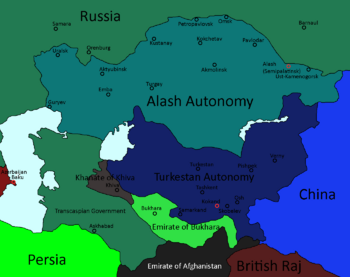تركستان الذاتية
Turkestan Autonomy بالقزخية: Түркістан автономиясы قرغيزية: Түркестан автономиясы بالطاجيكية: Мухторияти Туркистон اوزبكية: Туркистон мухторияти روسية: Туркестанская автономия | |||||||||
|---|---|---|---|---|---|---|---|---|---|
| 1917–1918 | |||||||||
 العلم | |||||||||
النشيد: Hymn of the Turkestan Autonomy | |||||||||
 Approximate borders of Turkestan Autonomy | |||||||||
| المكانة | Unrecognized state | ||||||||
| العاصمة | Kokand | ||||||||
| اللغات الشائعة | Uzbek Kazakh Kyrgyz Tajik Russian | ||||||||
| الدين | Secular state | ||||||||
| الحكومة | Republic | ||||||||
| الحقبة التاريخية | Russian Civil War | ||||||||
• Independence declared from Russia | 27 November 1917[أ] | ||||||||
• Sovietization of Turkestan | 22 February 1918 | ||||||||
| التعداد | |||||||||
• 1918 | Almost 5 million[citation needed] | ||||||||
| |||||||||
| Today part of | Kazakhstan Kyrgyzstan Tajikistan Uzbekistan | ||||||||
The Turkestan Autonomy, or Kokand Autonomy, was an unrecognized state[بحاجة لمصدر] in Central Asia that existed at the beginning of the Russian Civil War. It was formed on 27 November 1917[أ] and existed until 22 February 1918.[بحاجة لمصدر] It was a secular republic,[بحاجة لمصدر] headed by a president.[2]
It was one of the first secular states where the majority of the population were Muslims.[بحاجة لمصدر] It was the first democratic state in the history of Central Asia.[بحاجة لمصدر] The capital of the state was Kokand, which until then was the capital of the Kokand Khanate. There were 5 official languages: Uzbek, Kazakh, Kyrgyz, Tajik and Russian. The population was about 5 million people,[بحاجة لمصدر] mostly Uzbeks and Kazakhs, as well as Kyrgyz, Tajiks, Russians and others.[بحاجة لمصدر]
التاريخ
The Turkestan Autonomy occupied former territories of the Russian Empire, which was called the Turkestan Krai or the Russian Turkestan, more particular parts of the Semirechye, Syr-Darya and Fergana Oblasts (Provinces). From the north it bordered on the Alash Autonomy, from the east on the Republic of China, from the south on the Emirate of Afghanistan, from the south-west on the Emirate of Bukhara, on the west and north-west on the Soviet Central Asian Regions.
The state was created by Jadids and Kadimis. The government of Turkestan autonomy in January announced its intention to convene its parliament on 20 March 1918,[1] on the basis of universal, direct, equal and secret ballot. Two-thirds of the seats in parliament were intended for Muslim deputies, and one-third was guaranteed to representatives of the non-Muslim population.[1] The existence of such a parliament was to be the first step towards the democratization of Turkestan.[بحاجة لمصدر]
In January 1918, in response to an ultimatum from the Soviets on the voluntary inclusion into Soviet Russia, Mustafa Shokay refused to recognize the authority of the Soviets. For the destruction of the self-proclaimed Turkestan Autonomy, 11 trains with troops and artillery under the command of Konstantin Osipov arrived from Moscow in Tashkent. As a result of hostilities, thousands of civilians were killed.[بحاجة لمصدر] Thus, the Turkestan autonomy was liquidated by the Bolsheviks only three months after its creation. It was replaced by Turkestan Autonomous Soviet Socialist Republic.[بحاجة لمصدر]
In November 1917, Muhamedzhan Tynyshpaev was the first president of the state.[2] The second and last president was Mustafa Shokay.[2]
انظر أيضاً
Notes
- ^ أ ب November 28 in Kazakh-language sources.[مطلوب توضيح][1]
References
- ^ أ ب ت Dauletbayeva, Altynzer (2017). "Turkestan Autonomy and legends about Mustafa Shokay". e-history.kz (in الإنجليزية). Ministry of Information and Communications of the Republic of Kazakhstan.
- ^ أ ب ت Bergne, Paul (2003). "The Kokand Autonomy 1917–1918". In Everett-Heath, Tom (ed.). Central Asia: Aspects of Transition (in الإنجليزية). Psychology Press. p. 30–44. ISBN 978-0-7007-0957-1.
General references
- "Turkiston Muxtoriyati" entry in the National Encyclopedia of Uzbekistan. (in أوزبكية)
- جميع الصفحات التي تحتاج تنظيف
- مقالات بالمعرفة تحتاج توضيح from April 2019
- Short description matches Wikidata
- Articles containing قزخ-language text
- Articles containing Kyrgyz-language text
- Articles containing طاجيكية-language text
- Articles containing أوزبكية-language text
- Articles containing روسية-language text
- Pages using Lang-xx templates
- Articles with unsourced statements from April 2019
- مقالات ذات عبارات بحاجة لمصادر
- Articles with أوزبكية-language sources (uz)
- 1917 establishments in Asia
- 1918 disestablishments in Asia
- History of Uzbekistan
- History of Kazakhstan
- Post–Russian Empire states
- Former countries in Central Asia
- States and territories established in 1917
- Turkic states